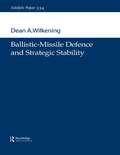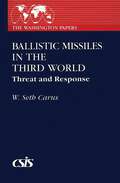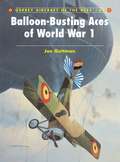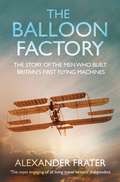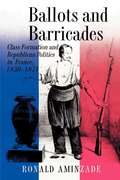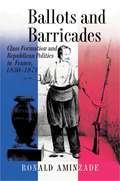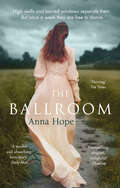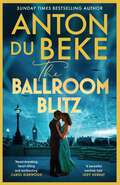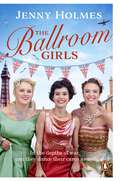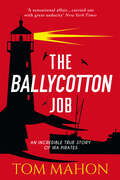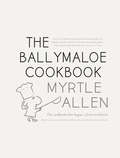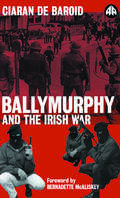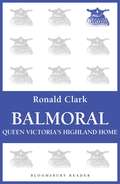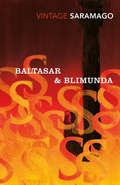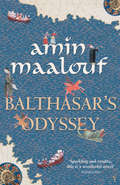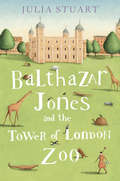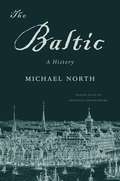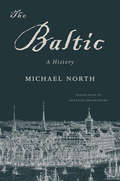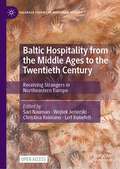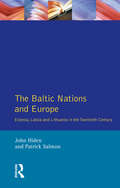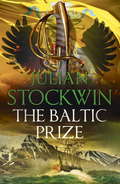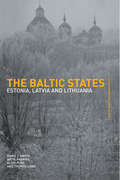- Table View
- List View
Ballistic-Missile Defence and Strategic Stability (Adelphi series #334)
by Dean A. WilkeningShould the US deploy ballistic-missile defences? The arguments for and against are becoming increasingly polarised. This paper offers what is currently lacking in the debate: a quantitative analysis of how well defences would have to work to meet specific security objectives, and what level of defence might upset strategic stability.
Ballistic Missiles in the Third World: Threat and Response (The Washington Papers)
by W. Seth CarusThe proliferation of ballistic missiles in the Third World has posed a new type of challenge to policy makers in the United States. More than twenty Third World countries either possess surface-to-surface missiles or are trying to develop or acquire them. Current trends suggest that the number of countries with missiles will increase in the 1990s and that the capabilities of the available systems will also grow. W. Seth Carus assesses the threat of such proliferation to United States military forces as well as those of its allies operating in the Third World. The book studies the military utility of these missiles to the countries that possess them and covers the various military responses of Third World countries to missile proliferation.Carus also examines the various attempts the United States has made to slow the proliferation of ballistic missiles. Washington has joined many of its allies in the Missile Technology Control Regime (MTCR), a suppliers agreement designed to restrict exports of missiles and missile technologies to the Third World. According to Carus, efforts have been made to persuade the Soviet Union, China and other countries to abide by the provisions of the MTCR. After discussing the bilateral talks with proliferating countries, Carus also analyzes the attempts made to derail specific missile programs and the difficulties involved in controlling missile technology.
Balloon-Busting Aces of World War 1 (Aircraft of the Aces)
by Jon Guttman Harry DempseyTethered balloons reached their zenith as a means of providing a stationary observation platform above the battlefield during World War I. It took a special breed of daredevil to take on such odds deep in enemy lines in order to destroy a balloon, with Balloon specialists such as Willy Coppens, Pierre Bourjade and Michel Coiffard rising to the challenge. This book covers the story of these 'balloon busters' from both sides in World War 1 through a mix of first-hand accounts and expert analysis, which compares tactics, theatres of operation, aircraft types and the overall odds for success.
Balloon-Busting Aces of World War 1 (Aircraft of the Aces #66)
by Jon Guttman Harry DempseyTethered balloons reached their zenith as a means of providing a stationary observation platform above the battlefield during World War I. It took a special breed of daredevil to take on such odds deep in enemy lines in order to destroy a balloon, with Balloon specialists such as Willy Coppens, Pierre Bourjade and Michel Coiffard rising to the challenge. This book covers the story of these 'balloon busters' from both sides in World War 1 through a mix of first-hand accounts and expert analysis, which compares tactics, theatres of operation, aircraft types and the overall odds for success.
The Balloon Factory: The Story of the Men Who Built Britain's First Flying Machines
by Alexander FraterAt the heart of his story lies the Balloon Factory, a cathedral-sized shed overlooking Farnborough Common, and its most celebrated occupant, the remarkable long-haired gun-toting ex-cowboy, Sam Cody. Frater, in a work that is part history, part travelogue, goes in search of some of the most extraordinary pioneers, including Sam Cody, John William Dunne, Sir George Cayley and Geoffrey De Havilland. His richly described and wonderfully anecdotal journey brings those magnificent men, the rock stars of their time, and the places they knew vibrantly to life. ‘Frater’s book is a treasure chest of facts wrapped in anecdotes . . . The Balloon Factory should be purchased in bulk by BA and substituted for the glossy in-flight magazine’ Literary Review ‘The Balloon Factory is the rarest of things – a thorough overview of a subject that manages to remain enjoyable and entertaining throughout.’ BBC Focus magazine ‘Alexander Frater is a renowned travel writer with an infectious interest in early aviation, a strong practical grasp of aeronautics and a gift for lyrical description . . .’ Sunday Telegraph ‘This is a beautifully written, amusing and educational tome . . . The author succeeds in really bringing the characters and events to life by visiting scenes of British aviation history, creating a real feeling for the people behind the events and doing it all in a way that you don’t need an anorak and binoculars to appreciate.’ Flyer magazine ‘One of my favourite non-fiction books of the year . . . ’ Ham & High and the Wood & Vale
Ballots and Barricades: Class Formation and Republican Politics in France, 1830-1871
by Ronald AminzadeUsing class analysis to understand the dynamics of political conflict in mid-nineteenth-century France, Ronald Aminzade explores political activity among workers in three industrialized French cities--Toulouse, Saint-étienne, and Rouen. A comparative case-study design enables the author to analyze how the complex interaction between industrialization, class relations, and party development fostered revolutionary communes in some cities but not others. Challenging traditional theories of industrialization and revolution, Aminzade innovatively uses narratives to provide a historically grounded analysis of the failed municipal revolutions of 1871 and the triumph of liberal-democratic institutions in France. In each of these cities, distinctive patterns of capitalist industrialization and class restructuring intersected with shifting political opportunities at the national level to produce local republican parties with different ideologies, strategies, and alliances. Focusing on changing relations between republican parties and male workers, whose identities and economic standing were in transition, Aminzade examines struggles within local parties among liberal, radical, and socialist republicans. The outcome of these struggles, he argues, shaped the willingness of workers to embrace the ballot box or take to the barricades.
Ballots and Barricades: Class Formation and Republican Politics in France, 1830-1871
by Ronald AminzadeUsing class analysis to understand the dynamics of political conflict in mid-nineteenth-century France, Ronald Aminzade explores political activity among workers in three industrialized French cities--Toulouse, Saint-étienne, and Rouen. A comparative case-study design enables the author to analyze how the complex interaction between industrialization, class relations, and party development fostered revolutionary communes in some cities but not others. Challenging traditional theories of industrialization and revolution, Aminzade innovatively uses narratives to provide a historically grounded analysis of the failed municipal revolutions of 1871 and the triumph of liberal-democratic institutions in France. In each of these cities, distinctive patterns of capitalist industrialization and class restructuring intersected with shifting political opportunities at the national level to produce local republican parties with different ideologies, strategies, and alliances. Focusing on changing relations between republican parties and male workers, whose identities and economic standing were in transition, Aminzade examines struggles within local parties among liberal, radical, and socialist republicans. The outcome of these struggles, he argues, shaped the willingness of workers to embrace the ballot box or take to the barricades.
The Ballroom: A Richard and Judy book club pick
by Anna HopeA RICHARD AND JUDY BOOK CLUB PICK AUTUMN 2016'Absolutely heart-breaking. One of the best books I’ve ever read' DINAH JEFFERIES, author of The Tea-Planter's Wife'Compelling, elegant and insightful' Observer'Beautifully wrought, tender, heartbreaking' Sunday Express 5/5'Moving, fascinating' Times'A tender and absorbing love story' Daily Mail'Unsentimental and affecting' Sunday Times'Exquisitely good' Metro1911: Inside an asylum at the edge of the Yorkshire moors,where men and women are kept apartby high walls and barred windows,there is a ballroom vast and beautiful.For one bright evening every weekthey come together and dance.When John and Ella meetIt is a dance that will changetwo lives forever.Set over the heatwave summer of 1911, the end of the Edwardian era, THE BALLROOM is a historical love story. It tells a page-turning tale of dangerous obsession, of madness and sanity, and of who gets to decide which is which.
The Ballroom Blitz
by Anton Du BekeThe stunning new Buckingham novel from Sunday Times bestselling author Anton Du Beke.September 1940. As the skies split apart and bombs rain down on London, it's all the staff at the famed Buckingham Hotel can do to keep their guests in the luxury they're accustomed to, and evoke the magic of the Grand ballroom for them each night. Home on leave and still reeling from the tragic events at Dunkirk, the dashing Raymond de Guise struggles to define his role in this new world, and to do his duty both to his country, and his beloved wife Nancy- who needs him now more than ever. With profiteers skulking the London streets, and devious rivals plotting the Buckingham's downfall, the hotel staff must all hold onto what matters most- and decide where their loyalties truly lie. As the bombing intensifies and Christmas fast approaches, somehow the show must go on...
The Ballroom Girls: A spellbinding and heart-warming new WWII romance (The Ballroom Girls Book 1) (Ballroom Girls #1)
by Jenny Holmes**The first book in Jenny Holmes's brand-new WWII saga series - The Ballroom Girls. Perfect for fans of Nancy Revell and Donna Douglas. **Blackpool, summer 1942. Meet the Ballroom Girls: Sylvia, Pearl and Joy. Three girls dancing through the turbulence of WWII. Sylvia is the spoiled only child of an ambitious mother, Lorna Ellis, who runs a dancing school in Blackpool. Approaching 21, Sylvia is under pressure to scoop up prizes by fair means or foul.Pearl is the oldest daughter in a large, chaotic family who all work at the Pleasure Beach. She often sneaks away to watch ballroom contestants in their glittery finery. She dreams of joining them, but will she ever be anything other than an outsider looking in?Joy is an evacuee who lost her parents to the Blitz. Now she lives and works in a shabby boarding house and works as a cleaner. Though shy and modest, she falls in love with the newest dance craze - the American Jitterbug. When Lorna's rival dance school spots her talent, Joy is given a chance to break away from boarding house drudgery and enter the glamorous world of professional ballroom dancing.Through blackouts and air raids, the excitement of the ballroom never dims. But competition is fierce. Will the Ballroom Girls find what they're looking for in the joy of the dance? Readers LOVE Jenny Holmes's WWII sagas:'There wasn't anything I didn't like about this book' 5 star review'In all the women at war series of book I have read so far, I think this is the best' 5 star review'I couldn't put this book down' 5 star review'Loved the whole story. Hated it coming to an end' 5 star review'Just the kind of book I like' 5 star review
The Ballroom Girls: Curl up with this festive, heartwarming and uplifting historical romance book (Ballroom Girls #2)
by Jenny HolmesAs war rages on, can they keep dancing?Blackpool, November 1942Wartime worries fail to dampen the glitz and glamour of the ballroom in the run-up to Christmas. After all, life is for living.Newlywed Pearl's bliss is cut short when her beloved Bernie is called up into the Army. Will dancing at the Tower Ballroom take the edge off her heartache or will it throw temptation her way?Unexpected news of an inheritance presents Joy with a different dilemma. Should she move to Scotland in line with her parents' final wishes or stay in Blackpool to dance with Tommy, the man she loves?Meanwhile, ambitious Sylvia ditches Eddie, her loyal dance partner and launches into a new career teaching jive and jitterbug. Regrets soon set in, however. Is this the worst mistake she's ever made?Change is in the air. Can our Ballroom Girls fulfil their dreams and make this a Christmas to remember?
The Ballycotton Job: An incredible true story of IRA Pirates
by Tom MahonA ‘sensational affair.. carried out with great audacity’ - New York Times. An astonishing act of piracy, the capture of the British war ship, the Upnor changed the course of Ireland's Civil War. Flawless in its planning and execution, while Winston Churchill remarked on Irish 'genius for conspiracy', a furious Michael Collins accused the British of deliberately arming his enemies. Indeed, it’s highly likely that the bullet that killed him originated in the Upnor. The Ballycotton Job brings this riveting story to life, its cast of disparate characters and strands of adventure beautifully woven together. This book sees events leading up to the capture as well as the consequences of the Upnor seizure discussed in detail. Based on years of archival research, it tells a unique story of both sides, Irish and British. The book's fast-paced narrative is enlivened by dialogue and details obtained from interviews with participants. Ireland teetered on the verge of civil war, the IRA splitting into anti-Treaty and pro-Treaty stance, Michael Collins and the Provisional Government on the pro-Treaty side. Cork's Sean O’Hegarty, the local anti-Treaty IRA leader, prevented Collins’ National Army from entering the city. As the British evacuated soldiers and equipment back to England, O’Hegarty came up with a brilliant plan to capture the munitions en route. Commandeering a tugboat from the Royal Navy base at Queenstown/Cobh, they sped out of the fortified harbour on a mission. Simultaneously, over eighty trucks and lorries were hijacked all across Cork, leaving citizens mystified as to what was going on. In a clever ruse, the IRA squad captured arms ship Upnor, bringing it into the small port of Ballycotton. The village, now under the control of IRA fighters, witnessed the unloading of weaponry onto waiting lorries then driven off to secret arms dumps throughout Cork. O’Hegarty's men seized eighty tons of arms, subsequently distributed to southern IRA divisions during the Civil War. This audacious act of piracy caused a sensation. A field day for the newspapers, The Irish Independent called it ‘an amazing exploit’; The Times ‘a clever and daring coup’.
The Ballymaloe Cookbook, revised and updated 50-year anniversary edition: Classic recipes from Myrtle Allen’s award-winning restaurant at Ballymaloe House
by Myrtle AllenFirst published in 1977, The Ballymaloe Cookbook espouses a food philosophy rare for its time, but now so prevalent that this revised and updated edition shows just what an impact Myrtle Allen has made.With classic, simple recipes, The Ballymaloe Cookbook is the ultimate kitchen cookery manual, packed with priceless tips from a true master chef, such as ‘how to get a carrot to taste like a carrot’ and ‘how not to drown a fresh fish’!Myrtle’s charming food writing contains a world of wisdom that reveals a woman of great foresight, and not only where food is concerned. It is an elegant tribute to an authentic and sustainable way of life to which many of us are now seeking to return.This new edition of The Ballymaloe Cookbook marks both Myrtle’s ninetieth birthday and fifty years of her award-winning, internationally renowned restaurant at Ballymaloe House. Containing many new recipes, the book is a celebration of modern Irish cooking at its best.The Ballymaloe Cookbook: Table of ContentsSoups and StartersSaucesFish and ShellfishPoultryMeatVegetablesSweets and IcesTarts, Breads and CakesPâtés, Cheese and EggsSome Drinks
Ballymurphy and the Irish War
by Ciaran de Baroid‘One of the most remarkable books to emerge from the Northern conflict. I can’t recall any other book which gives the reader the same accessibility to the streets of Belfast.’ Irish Post*BR**BR*‘A thrilling people’s history of Belfast’s most famous housing estate which will be remembered as one of the classic books to emerge from the Troubles.’ Andersonstown News
Balmoral: Queen Victoria's Highland Home
by Ronald ClarkFirst published in 1981, this is Ronald Clark's engagingly readable account of Queen Victoria's relationship with "Our dear Balmoral" and the life that went on there. The biography of Balmoral begins with the first visit to Scotland of the young Queen Victoria and her husband Prince Albert in 1842. Five years later, while bad weather envelops the Royal party in western Scotland, the son of the Queen's physician, convalescing in Old Balmoral, reports blazing sunshine from Upper Deeside. The death of his host shortly afterwards opens the way for the Royal acquisition of the Balmoral estate and the building of the new Castle in 1853-55. In the period up to Albert's death in 1861 Balmoral becomes the setting for many of the Royal couple's happiest moments as they revel in the beauties of the scenery, relish the picturesque pageantry of Highland life, enjoy their incognito expeditions into the surrounding country, and - in Albert's case - discover a passionate enthusiasm for deer-stalking. After the Prince Consort's death Balmoral becomes a mausoleum of memories, but also a source of strength enabling the Queen to survive her devastating loss. About the time of the Golden Jubilee of 1887 there is an Indian summer, with members of the Queen's extensive family rallying round and dances and entertainments displacing some of the black-crepe gloom. In 1896 there is the colorful visit of the Tsar, with his wife and daughter. The closing section links Victorian Balmoral with the life of the Castle today.
Baltasar & Blimunda
by José SaramagoIn early eighteenth-century Lisbon, Baltasar, a soldier who has lost his left hand in battle, falls in love with Blimunda, a young girl with visionary powers. From the day that he follows her home from the auto-da-fe where women are burned at the stake, the two are bound body and soul by love of an unassailable strength. A third party shares their supper that evening: Padre Bartolomeu Lourenco, whose fantasy is to invent a flying machine. As the Crown and the Church clash, they purse his impossible, not to mention heretical, dream of flight.
Balthasar's Odyssey: A Novel
by Amin MaaloufThere are ninety-nine names for God in the Koran, is it possible that there is a secret one-hundredth name? In this tale of magic and mystery, of love and danger, Balthasar's ultimate quest is to find the secret that could save the world. Before the dawn of the apocalyptic 'Year of the Beast' in 1666, Balthasar Embriaco, a Genoese Levantine merchant, sets out on an adventure that will take him across the breadth of the civilised world, from Constantinople, through the Mediterranean, to London shortly before the Great Fire. Balthasar's urgent quest is to track down a copy of one of the rarest and most coveted books ever printed, a volume called 'The Hundredth Name', its contents are thought to be of vital importance to the future of the world. There are ninety-nine names for God in the Koran, and merely to know this most secret hundredth name will, Balthasar believes, ensure his salvation.
Balthazar Jones and the Tower of London Zoo
by Julia StuartA poignant, magical and completely original novel that you can’t fail to love, for fans of Joanne Harris.
The Baltic: A History
by Michael NorthFrom the Vikings to the EU the Baltic has been a Nordic Mediterranean, a shared maritime zone with distinct patterns of trade, cultural exchange, and conflict. Covering a thousand years in a part of the globe where seas are more connective than land, Michael North’s overview transforms the way we think about one of the world’s great waterways.
The Baltic: A History
by Michael NorthFrom the Vikings to the EU the Baltic has been a Nordic Mediterranean, a shared maritime zone with distinct patterns of trade, cultural exchange, and conflict. Covering a thousand years in a part of the globe where seas are more connective than land, Michael North’s overview transforms the way we think about one of the world’s great waterways.
Baltic Hospitality from the Middle Ages to the Twentieth Century: Receiving Strangers in Northeastern Europe (Palgrave Studies in Migration History)
by Christina Reimann Wojtek Jezierski Sari Nauman Leif RunefeltReflecting debate around hospitality and the Baltic Sea region, this open access book taps into wider discussions about reception, securitization and xenophobic attitudes towards migrants and strangers. Focusing on coastal and urban areas, the collection presents an overview of the responses of host communities to guests and strangers in the countries surrounding the Baltic Sea, from the early eleventh century to the twentieth. The chapters investigate why and how diverse categories of strangers including migrants, war refugees, prisoners of war, merchants, missionaries and vagrants, were portrayed as threats to local populations or as objects of their charity, shedding light on the current predicament facing many European countries. Emphasizing the Baltic Sea region as a uniquely multi-layered space of intercultural encounter and conflict, this book demonstrates the significance of Northeastern Europe to migration history.
The Baltic Nations and Europe: Estonia, Latvia and Lithuania in the Twentieth Century
by John Hiden Patrick SalmonOf all the Soviet Union's subject nationalities, the three Baltic republics, Estonia, Latvia and Lithuania, were the most determined and best organised in seizing the opportunities created by glasnost and perestroika to win freedom from Moscow's grip.At the time of first publication, in 1991, the final section of the book was speculative. Now for this revised edition, the authors have provided a new final chapter which brings the story up to date -- and the three republics to political independence again.
The Baltic Nations and Europe: Estonia, Latvia and Lithuania in the Twentieth Century
by John Hiden Patrick SalmonOf all the Soviet Union's subject nationalities, the three Baltic republics, Estonia, Latvia and Lithuania, were the most determined and best organised in seizing the opportunities created by glasnost and perestroika to win freedom from Moscow's grip.At the time of first publication, in 1991, the final section of the book was speculative. Now for this revised edition, the authors have provided a new final chapter which brings the story up to date -- and the three republics to political independence again.
The Baltic Prize: Thomas Kydd 19 (Thomas Kydd)
by Julian Stockwin1808. Parted from his new bride, Captain Sir Thomas Kydd is called away to join the Northern Expedition to Sweden, now Britain's only ally in the Baltic. Following the sudden declaration of war by Russia and with the consequent threat of the czar's great fleet in St Petersburg, the expedition must defend Britain's dearly-won freedom in those waters. However Kydd finds his popular fame as a frigate captain is a poisoned chalice; in the face of jealousy and envy from his fellow captains, the distrust of the commander-in-chief and the betrayal of friendship by a former brother-in-arms now made his subordinate, can he redeem his reputation?In an entirely hostile sea Tyger ranges from the frozen north to the deadly confines of the Danish Sound - and plays a pivotal role in the situation ensuing after the czar's sudden attack on Finland. This climaxes in the first clash of fleets between Great Britain and Russia in history. To the victor will be the prize of the Baltic!******************PRAISE FOR JULIAN STOCKWIN'S THOMAS KYDD SERIES'Paints a vivid picture of life aboard the mighty ship-of-the-line' Daily Express'This heady adventure blends fact and fiction in rich, authoritative detail' Nautical Magazine on VICTORY'Fans of fast-paced adventure will get their fill with this book' Historical Naval Society on THE ADMIRAL'S DAUGHTER
The Baltic States: Estonia, Latvia and Lithuania (Postcommunist States and Nations #3)
by Thomas Lane Artis Pabriks Aldis Purs David J. SmithSince the end of the Cold War there has been an increased interest in the Baltics. The Baltic States brings together three titles, Estonia, Latvia and Lithuania, to provide a comprehensive and analytical guide integrating history, political science, economic development and contemporary events into one account. Since gaining their independence, each country has developed at its own pace with its own agenda and facing its own obstacles. The authors examine the tensions accompanying a post-communist return to Europe after the long years of separation and how each country has responded to the demands of becoming a modern European state. Estonia was the first of the former Soviet republics to enter membership negotiations with the European Union in 1988 and is a potential candidate for the next round of EU expansion in 2004. Lithuania and Latvia have also expressed their desire for future membership of NATO and the EU.
